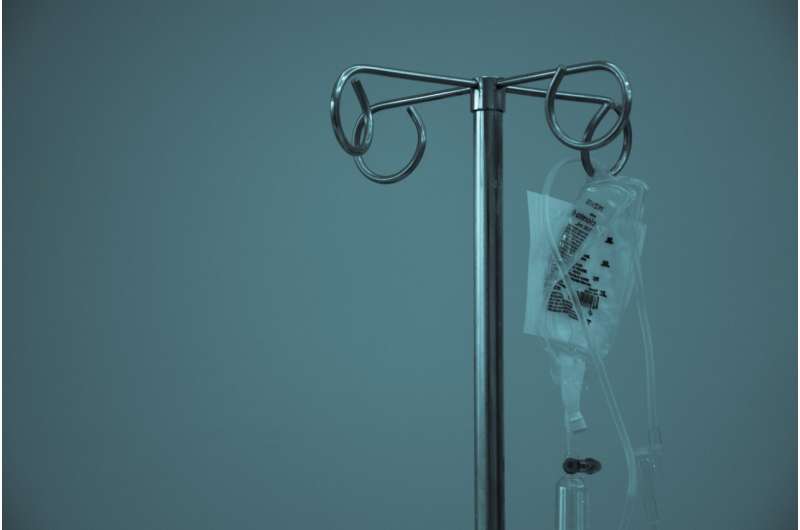This article has been reviewed according to Science X's editorial process and policies. Editors have highlighted the following attributes while ensuring the content's credibility:
fact-checked
peer-reviewed publication
trusted source
proofread
The last word on sepsis: IV fluids help … except when they don't

When doctors around the world want to know the latest treatment advice for a particular disease, they've turned to the Journal of the American Medical Association (JAMA) to find clear and concise summaries written by leading experts since 1883.
Today they're reading advice from two University of Alberta researchers on how to use intravenous fluids to treat sepsis, a deadly condition that affects nearly a third of all patients in intensive care units.
Despite the fact that IV fluid therapy is one of the standard pillars of care for sepsis, it's not always a sure bet—in fact, as the authors outline in their paper, giving IV fluids can sometimes make sepsis worse.
Which fluids to give, how much to give and when have been fiercely debated for years.
"This is an intervention that is cheap and easy to use and it can be life-saving, but it can also be harmful for patients if too much fluid is given," explains first author Fernando Zampieri, a newly recruited assistant professor at the U of A who was invited to lead the paper because of his work on clinical trials to definitively answer those questions.
The new JAMA article sums up the latest science on the phases of sepsis and how much IV fluid to give at each stage of treatment.
"It's aimed at the clinician who works on the wards, who works in community hospitals, who works in emergency departments, explaining the mechanisms to assess whether patients are responding or not and decide whether more fluid needs to be given," says Sean Bagshaw, professor and chair of critical care medicine, and Canada Research Chair in Critical Care Outcomes and Systems Evaluation, who co-wrote the paper with Zampieri and Matthew Semler of Vanderbilt University.
"These are really fundamental issues that have been challenging for clinicians to reconcile and have long been controversial, so this concise review bundles all recent evidence together," Bagshaw says.
A complex and life-threatening condition
Twenty-five percent of patients who develop sepsis die from it, and it's responsible for 11 million deaths per year, Zampieri estimates. Sepsis is an extreme response by the body to an infection, leading to a drop in blood pressure and thus a lack of oxygen circulation. Death occurs when oxygen-deprived organs such as the brain, kidneys or liver fail.
Treatment almost always includes administering intravenous fluids, along with other interventions such as antibiotics and medications to boost blood pressure and oxygen delivery to tissues. The goal is to restore circulation without causing edema, or swelling, which can also be harmful to organs.
Sepsis can occur at any time in life from infancy to old age, says Bagshaw, who is a member of the Women and Children's Health Research Institute. As Zampieri points out, sepsis is not really one disease, but a complex condition with multiple causes.
"When we talk about sepsis, you can be talking about things as different as a young woman with an infection after delivery all the way through to an elderly patient with a urinary tract infection. Those are two completely separate sources of infection, and the patient's other conditions make treatment more complicated," he says.
Zampieri says there are numerous clinical trials underway to refine sepsis treatment, but much is still unknown. Zampieri himself has been involved with trials in Brazil to determine whether slower fluids make a difference to clinical outcomes, to compare the efficacy of using saline versus a balanced solution of sodium, potassium and chloride that is more similar to bodily fluids, and to find out whether measuring lactic acid, which is produced when the body is starved of oxygen, is a good indicator of whether enough fluids have been given.
Digging for evidence to improve practice
Zampieri plans to continue his program of clinical trials and also wants to help physicians and health systems adopt best treatment practices as they are verified. Eventually he hopes to develop an accurate bedside test, such as using ultrasound, to better determine what level of fluids a patient requires.
"Clinical trials are the best way to provide evidence that will change practice," he says.
Bagshaw expects sepsis treatment to improve rapidly over the next decade thanks to such work.
"It took us 30 or 40 years to get to this point, and I think there's still lots of questions to be answered about how best to individualize the resuscitation strategies among patients with life-threatening infection and sepsis," Bagshaw says. "My hope is that Fernando will help catalyze some of those advances here at the U of A."
More information: Fernando G. Zampieri et al, Fluid Therapy for Critically Ill Adults With Sepsis, JAMA (2023). DOI: 10.1001/jama.2023.7560



















